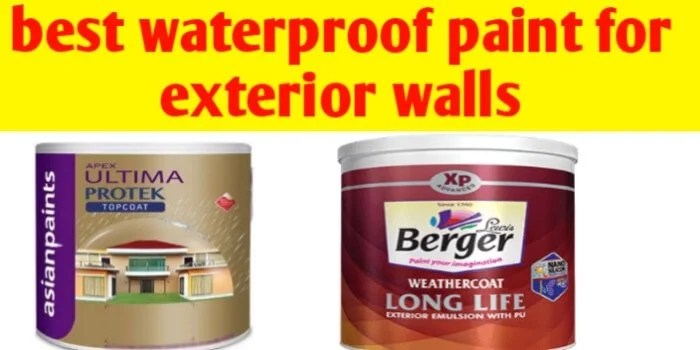When it comes to protecting your home from the elements, waterproof exterior paint solutions are a crucial investment. In this guide, we will delve into the different types available, factors to consider before choosing, tips for preparation and application, and maintenance practices to ensure longevity.
Get ready to transform your exterior surfaces with the ultimate protection!
Types of Waterproof Exterior Paint Solutions
When it comes to protecting exterior surfaces from the elements, there are several types of waterproof paint solutions available in the market. Each type has its own set of benefits and drawbacks, catering to different needs and preferences of consumers.
Below are some common types of waterproof exterior paint solutions along with examples of popular brands:
Elastomeric Paint
Elastomeric paint is a flexible and durable option that can stretch to accommodate movement in the surface. It provides excellent waterproofing and weather resistance, making it ideal for areas prone to cracking or peeling. Popular brands offering elastomeric paint include Behr, Sherwin-Williams, and Valspar.
Acrylic Paint
Acrylic paint is known for its fast-drying properties and resistance to fading and mildew. While it offers good waterproofing capabilities, it may not be as durable as elastomeric paint. Some popular brands of acrylic paint for exteriors are Benjamin Moore, Dunn-Edwards, and PPG.
Oil-based Paint
Oil-based paint provides a tough and long-lasting finish that is resistant to abrasion and moisture. It offers excellent adhesion to various surfaces but may require more time to dry compared to other types of paint. Brands like Rust-Oleum, KILZ, and Glidden offer quality oil-based paints for exterior use.
Stain and Sealer Combo
Stain and sealer combinations are popular for enhancing the natural beauty of wood while providing protection against water damage. They penetrate the surface to create a waterproof barrier that also resists UV rays. Some well-known brands offering stain and sealer combos are Thompson's WaterSeal, Olympic, and Cabot.
Ceramic Paint
Ceramic paint is a high-performance option that offers exceptional durability and resistance to harsh weather conditions. It forms a protective barrier that repels water and prevents cracking or peeling. Brands like Dulux, Nippon Paint, and Asian Paints are known for their quality ceramic paints for exterior surfaces.
Factors to Consider When Choosing Waterproof Exterior Paint
When selecting waterproof exterior paint solutions, there are several important factors to keep in mind to ensure the best results for your surfaces. Factors such as climate, location, color, and finish play a crucial role in determining the effectiveness and longevity of the paint.
Climate and Location
When choosing waterproof exterior paint, it is essential to consider the climate and location of your property. Different climates require different types of paint to withstand extreme weather conditions such as rain, snow, heat, and humidity. For example, if you live in a region with high humidity, it is important to choose a paint that is mold and mildew resistant.
- For areas prone to heavy rainfall, opt for a paint that offers superior water resistance to prevent water damage and moisture penetration.
- In regions with high UV exposure, choose a paint with UV protection to prevent fading and discoloration over time.
- Consider the temperature fluctuations in your area when selecting paint to ensure it can expand and contract without cracking or peeling.
Choosing the Right Color and Finish
The color and finish of the paint you choose for your exterior surfaces can impact both the aesthetic appeal and durability of the paint. It is important to select a color that complements your home's architecture and landscaping while also considering practical factors such as heat absorption and fading.
- Lighter colors reflect sunlight and heat, making them ideal for warmer climates to help reduce energy costs and prevent heat buildup.
- Darker colors absorb heat and can help keep your home warmer in colder climates, but they may also fade more quickly over time.
- Choose a finish, such as matte, satin, or gloss, based on the level of sheen you desire and the level of maintenance you are willing to commit to.
Preparation and Application of Waterproof Exterior Paint
Before applying waterproof exterior paint, it is crucial to properly prepare the surface to ensure a smooth and long-lasting finish. Here are the necessary steps for preparing the surface:
Surface Preparation Steps:
- Clean the surface thoroughly to remove dirt, dust, and any previous coatings. Use a pressure washer or scrub brush with a cleaning solution.
- Repair any cracks, holes, or damaged areas on the surface using an appropriate filler or patching compound. Allow it to dry completely before proceeding.
- Sand the surface to create a smooth and even texture, ensuring better adhesion of the paint. Remove any loose paint or debris.
- Apply a primer specifically designed for exterior surfaces to enhance adhesion and provide a uniform base for the waterproof paint.
Application Process for Waterproof Paint Solutions:
- Follow the manufacturer's instructions carefully for the specific type of waterproof paint you are using, whether it is elastomeric, acrylic, or silicone-based.
- Use high-quality brushes, rollers, or sprayers for application to achieve a uniform and consistent coat of paint on the surface.
- Apply multiple thin coats of waterproof paint, allowing sufficient drying time between each coat as recommended by the manufacturer.
- Pay attention to temperature and humidity conditions during application, as they can affect the drying and curing process of the paint.
Tips for Ensuring a Smooth and Long-Lasting Finish:
- Avoid painting in direct sunlight or extreme temperatures, as this can cause the paint to dry too quickly or not adhere properly.
- Inspect the painted surface regularly for any signs of peeling, cracking, or water damage, and address any issues promptly to prevent further damage.
- Consider applying a clear waterproof sealant over the painted surface for added protection against moisture and UV rays.
- Maintain the painted surface by cleaning it regularly and performing touch-ups as needed to prolong the life of the waterproof paint.
Maintenance and Longevity of Waterproof Exterior Paint

Proper maintenance practices are essential to prolong the life of waterproof exterior paint. By following a few simple steps, you can ensure that your paint stays looking fresh and protects your home for years to come.
Identifying Signs of Wear
- Regularly inspect the exterior of your home for any signs of peeling, cracking, or bubbling paint.
- Look out for discoloration or fading, as this could indicate UV damage.
- Check for any moisture or water damage that could be compromising the paint's effectiveness.
When to Reapply or Touch Up
- If you notice any of the signs mentioned above, it's time to consider reapplying or touching up the paint.
- It's recommended to repaint every 5-7 years to maintain the waterproofing properties of the paint.
- Address any small areas of damage promptly to prevent further deterioration.
Expert Advice for Longevity
- Choose a high-quality waterproof exterior paint from a reputable brand for better durability.
- Follow the manufacturer's instructions for application and maintenance to ensure optimal performance.
- Consider adding an extra coat of paint or a protective sealant for added longevity.
Ending Remarks
In conclusion, waterproof exterior paint solutions offer not just protection but also aesthetic appeal for your home. By understanding the types, factors to consider, and maintenance tips, you can make informed decisions to keep your exterior looking its best for years to come.
Take the first step towards a beautifully protected home today!
Commonly Asked Questions
What are the benefits of waterproof exterior paint solutions?
Waterproof exterior paint solutions provide protection against moisture, UV rays, and harsh weather conditions, extending the life of your exterior surfaces.
How do I choose the right color for my exterior surfaces?
Consider the architectural style of your home, the surrounding landscape, and your personal preferences to choose a color that complements your overall aesthetic.
When should I reapply waterproof exterior paint?
Keep an eye out for signs of wear such as peeling or fading. It's recommended to reapply waterproof paint every 5-7 years for optimal protection.













